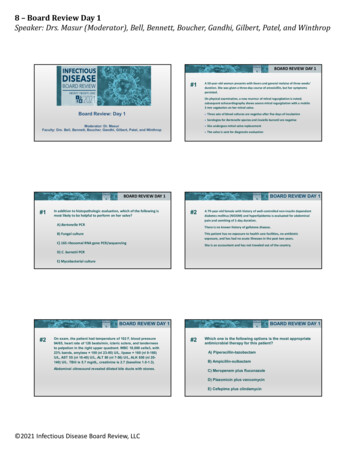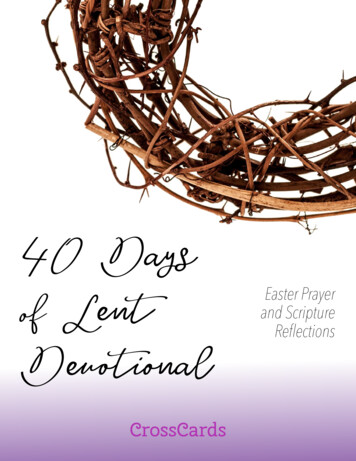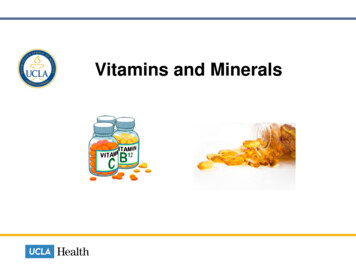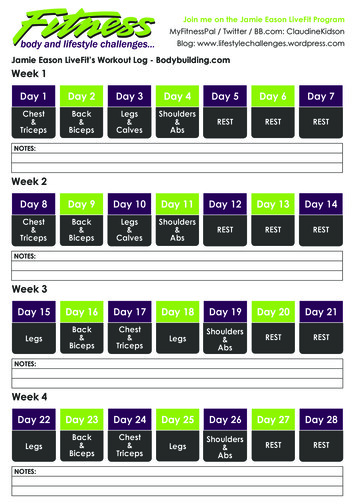
Transcription
8 – Board Review Day 1Speaker: Drs. Masur (Moderator), Bell, Bennett, Boucher, Gandhi, Gilbert, Patel, and WinthropBOARD REVIEW DAY 1#1A 50‐year‐old woman presents with fevers and general malaise of three weeks’duration. She was given a three‐day course of amoxicillin, but her symptomspersisted.On physical examination, a new murmur of mitral regurgitation is noted;subsequent echocardiography shows severe mitral regurgitation with a mobile3 mm vegetation on her mitral valve.Board Review: Day 1 Three sets of blood cultures are negative after five days of incubation Serologies for Bartonella species and Coxiella burnetii are negativeModerator: Dr. MasurFaculty: Drs. Bell, Bennett, Boucher, Gandhi, Gilbert, Patel, and Winthrop She undergoes mitral valve replacement The valve is sent for diagnostic evaluationBOARD REVIEW DAY 1BOARD REVIEW DAY 1#1In addition to histopathologic evaluation, which of the following ismost likely to be helpful to perform on her valve?#2A) Bartonella PCRA 79‐year‐old female with history of well‐controlled non‐insulin dependentdiabetes mellitus (NIDDM) and hyperlipidemia is evaluated for abdominalpain and vomiting of 1‐day duration.There is no known history of gallstone disease.B) Fungal cultureThis patient has no exposure to health care facilities, no antibioticexposure, and has had no acute illnesses in the past two years.C) 16S ribosomal RNA gene PCR/sequencingShe is an accountant and has not traveled out of the country.D) C. burnetii PCRE) Mycobacterial cultureBOARD REVIEW DAY 1#2On exam, the patient had temperature of 102 F, blood pressure94/65, heart rate of 126 beats/min, icteric sclera, and tendernessto palpation in the right upper quadrant. WBC 18,000 cells/L with23% bands, amylase 100 (nl 23-85) U/L, lipase 160 (nl 0-160)U/L, AST 55 (nl 10-40) U/L, ALT 80 (nl 7-56) U/L, ALK 650 (nl 20140) U/L. TBili is 5.7 mg/dL, creatinine is 2.7 (baseline 1.0-1.3).Abdominal ultrasound revealed dilated bile ducts with stones.BOARD REVIEW DAY 1#2Which one is the following options is the most appropriateantimicrobial therapy for this patient?A) Piperacillin-tazobactamB) Ampicillin-sulbactamC) Meropenem plus fluconazoleD) Plazomicin plus vancomycinE) Cefepime plus clindamycin 2021 Infectious Disease Board Review, LLC
8 – Board Review Day 1Speaker: Drs. Masur (Moderator), Bell, Bennett, Boucher, Gandhi, Gilbert, Patel, and WinthropBOARD REVIEW DAY 1#3A 36-year-old woman presented with a fever and skin eruptiontwo weeks after starting lamotrigine for depression. She had alsohad a mild, nonproductive cough for about ten days precedingthe initiation of lamotrigine for which she was giventrimethoprim-sulfamethoxazole by her family physician.BOARD REVIEW DAY 1#3On examination, she has a temperature of 38.3C, oral ulcers, andulcerating skin lesions over 75% of her body. Her conjunctiva areinflamed.Her lungs are clear, as is her chest radiograph. Her CBC shows aslight leukocytosis.Arch Dermatol. 2008;144(6):724‐726BOARD REVIEW DAY 1#3The most likely diagnosis is:BOARD REVIEW DAY 1#4A) Erythema multiformeThree days ago he noticed a red dot on his index finger that wasbecame increasingly painful. The lesion progressed to a redpurple involvement of his entire index finger, his middle finger,and most of the dorsum of his hand looking like a cellulitis.B) Stevens Johnson syndromeC) Toxic epidermal necrolysisHe is afebrile and says the involved area is quite painful but onlyslightly tender to the touch.D) Scalded skin syndromeHe says the finger joints feel stiff although there is no jointswelling on exam.E) Disseminated herpes simplexBOARD REVIEW DAY 1#4A 56-year-old commercial crab fisherman on the Chesapeake Bayis seen for a painful, red hand.Which one of the following is the most likely cause of hisproblem?A) Erysipelothrix rhusiopathiaeB) Mycobacterium chelonaeC) Sporothrix schenckiiD) AeromonasE) Pseudomonas aeruginosa 2021 Infectious Disease Board Review, LLCBOARD REVIEW DAY 1#5A 57-year-old medical school research scientist is seen for afebrile illness. Four days ago he was bitten on his hand by alaboratory rat.Last evening he had a fever, and today he has fever, chills,myalgias, and a painful left knee. On exam he is febrile. The bitewound is largely healed and has no evidence of infection.His left knee is swollen with obvious effusion and some pain onboth active and passive motion.He has a petechial rash over both shins, and it is also present onthe soles of his feet.
8 – Board Review Day 1Speaker: Drs. Masur (Moderator), Bell, Bennett, Boucher, Gandhi, Gilbert, Patel, and WinthropBOARD REVIEW DAY 1#5Which one of the following is the most likely cause of hisillness?BOARD REVIEW DAY 1#6He is recovering uneventfully with improving renal and hepaticfunction.A) Leptospira interrogansB) Spirillum minusOn the evening of his 6th post-operative day, he develops a feverof 38.5 CC) Streptobacillus moniliformisThe surgeons draw three cultures from an indwelling port thatwas placed preoperatively for chemotherapy that has not yetstarted. No other blood cultures were drawn.D) HantavirusE) Pasteurella canisPiperacillin-tazobactam is started.BOARD REVIEW DAY 1#6A 66-year-old patient in the ICU is day 6 post-operative followinga pancreatectomy for pancreatic carcinoma.On Day 7 the patient remains intermittently febrile but isotherwise stable with no new findings.BOARD REVIEW DAY 1#6Labs are remarkable only for a WBC that continues to declinefollowing surgery and is now 7800 cells/uL with 70% neutrophilsThe patient has been stable but still has a low-grade fever. Theport and the peripheral IV look fine, there are no other concerningphysical findings or lab values.The organisms have been identified as Staphylococcusepidermidis with an oxacillin MIC of 1 mcg/ml.An ID consult is requested because after 14 hours of incubation,all three blood cultures are growing Gram-positive cocci inclusters.The surgeon is very eager to retain the port. Because the patientis stable and will be hospitalized for starting his chemotherapy,you ask for port and peripheral blood cultures.At 48 hours, the port cultures are positive but peripheral culturesare negative.BOARD REVIEW DAY 1#6You recommend stopping the piperacillin-tazobactam. What elsewould you recommend?A) Vancomycin should be started, and the port should be removedB) Nafcillin or oxacillin should be started, and the port should beremovedC) Start vancomycin through the portD) Start nafcillin or nafcillin through the portE) Remove port. No antibiotic needed 2021 Infectious Disease Board Review, LLCBOARD REVIEW DAY 1#7A 57 y/o man presents with 1 week of fever, chills, and low backpain.A transesophageal echocardiogram shows a 6 mm mobile masson the mitral valve.MRI of the spine shows evidence of discitis between the 3rd and4th lumbar vertebrae.Admission blood cultures are positive for S. aureus resistantonly to penicillin.
8 – Board Review Day 1Speaker: Drs. Masur (Moderator), Bell, Bennett, Boucher, Gandhi, Gilbert, Patel, and WinthropBOARD REVIEW DAY 1#7He is treated with nafcillin 2 gm IV every 4 hours with resolutionof fever but little change in his back pain.BOARD REVIEW DAY 1#7Follow-up blood cultures form hospital days 4 and 5 are negative.Which of the following options is most appropriate for thispatient?A) Cefazolin 2 gm IV every 8 hoursThe white blood cell count, 18,000/mm3 with 90% neutrophils onadmission, but on hospital day 10, the white blood cell count is3,000/mm3 with 30% neutrophils.B) Ceftriaxone 2 gm IV every 12 hoursC) Linezolid 600 mg IV every 12 hoursRenal function is normal.D) Nafcillin 1 gm IV every 4 hoursE) Vancomycin 1 gm IV every 12 hoursBOARD REVIEW DAY 1#8A 72 y/o US born, white female reports a history of needingantibiotic therapy for repeated respiratory infections over the last12 months.BOARD REVIEW DAY 1#8She is a life-long non-smoker and has no risk factors fortuberculosis. She is otherwise healthy and takes no medications.Her chest radiograph is normal, but a chest computed tomograph(CT) reveals right middle lobe bronchiectasis with scattered treebud infiltrate, mucous plugging, and a small right upper lobecavity with a fungus ball present within the cavity.With each treatment she improves to near her baseline, butwithin several weeks her cough has worsened again, becamemore productive, and she complains of fatigue.Overall, she notes a decline in exercise capacity, 10 lbs weightloss, and progressive fatigue the last 6 months.BOARD REVIEW DAY 1#8The most likely cause of her syndrome and progressivedecline is:A) Mycobacterium gordonaeB) Chronic necrotizing aspergillosisC) Mycobacterium tuberculosisD) Mycobacterium avium complexE) Nocardia farcinica 2021 Infectious Disease Board Review, LLCBOARD REVIEW DAY 1#9A 72-year-old man develops fever, abdominal pain, and unstableblood pressure after a subtotal colectomy for carcinoma of thecolon.Empiric therapy with piperacillin-tazobactam and vancomycin isinitiated.Within hours, the Clinical Microbiology laboratory reports thatthe patient’s blood cultures are positive for enteric Gramnegative rods, preliminarily identified as Klebsiella pneumoniae.
8 – Board Review Day 1Speaker: Drs. Masur (Moderator), Bell, Bennett, Boucher, Gandhi, Gilbert, Patel, and WinthropBOARD REVIEW DAY 1#9BOARD REVIEW DAY 1#9In vitro, the K. pneumoniae is: Susceptible to: piperacillin-tazobactam, meropenem, cefepime,and colistinWhich one of the following antibiotics would you recommendfor specific therapy?A) Continue piperacillin-tazobactam Resistant to: ciprofloxacin, ceftriaxone and aztreonamB) Ceftazidime-avibactamC) GentamicinD) CefepimeE) MeropenemBOARD REVIEW DAY 1#10A 26-year-old male with HIV infection (CD4 50 cells/uL, Viral Load500,000 IU/mL) presents with severe right upper quadrant pain,nausea, vomiting and low-grade fever that suddenly occurredover the past 2 days.BOARD REVIEW DAY 1#10He lives in Washington, D.C., works as a tour guide, and eatsoften at a variety of downtown food carts.He has multiple sex partners and is not consistent about safe sexpractices.The patient has not been adherent to his antiretroviral therapyover the past several years.He intermittently uses methamphetamines.On exam he has normal vital signs (no fever at the time ofexamination) but severe right upper quadrant pain that is worsewith palpation.He has had diarrhea (6 watery stools per day) for 8 months, andhas lost 20 lbs during that period. The stools are brown, withoutblood or obvious mucous.BOARD REVIEW DAY 1#10CBC: WBC 4400, Platelets 270,000, Hct 43%Chemistries: liver function tests were moderately elevated: AST435 IU/L, ALT 530 IU/L, Alk Phos 561 IU/L, Total Bili 2.4 (mg/dl)BOARD REVIEW DAY 1#10What is the most likely cause of this syndrome?A) MethamphetaminesUrine toxicology screen positive for marijuana andamphetamines.B) CMVStool PCR, cultures, and ova and parasite exams are pending.C) LymphomaMRCP (Magnetic resonance cholangiopancreatography) revealsof bile duct stricture and moderate ductal dilation with no massesor adenopathy. Ultrasound and CT scan revealed similar findingsand also jejunal thickening and thickening of the gall bladderwall. 2021 Infectious Disease Board Review, LLCD) CryptosporidiosisE) Calculous cholecystitis
8 – Board Review Day 1Speaker: Drs. Masur (Moderator), Bell, Bennett, Boucher, Gandhi, Gilbert, Patel, and WinthropBOARD REVIEW DAY 1#11Which of the following is considered a serious hazard tolaboratory staff if not handled appropriately?BOARD REVIEW DAY 1#12A) Neisseria gonorrhoeaeHe underwent transurethral resection of a bladder cancer threemonths prior, and recently completed a six-week course ofintravesical Bacille Calmette Guerin (BCG) administered onceweekly.B) Haemophilus ducreyiC) Cryptococcus neoformansHe lives in Tucson, Arizona. Urinalysis shows protein, nitrite, andleukocytes; routine bacterial culture is negative. Chest X-ray isnormal. Chest CT scan shows innumerable tiny (1-4 mm)nodules.D) Coccidioides immitisE) Corynebacterium diphtheriaeBOARD REVIEW DAY 1#1275-year-old male with diabetes mellitus and ankylosingspondylitis treated with prednisone 20 mg daily, admitted with 3weeks of fevers to 39 C, lethargy, and weight loss of 10 lbsWhat diagnostic procedure is most likely to reveal thediagnosis?BOARD REVIEW DAY 1#13A previously healthy 60 y/o man presented with a few hours ofsevere pain in the right upper extremity.The exam was normal and he was discharged.A) Bacterial blood cultureOver the next few hours, he developed progressive swelling ofthe right upper extremity. There was no history of trauma.B) Silver stain of induced sputumOn exam, he appeared anxious, with cold and clammy skin.C) Ziehl-Neelsen stain of induced sputumD) Trans-bronchial biopsyE) Serum antibody testing for CoccidioidesBOARD REVIEW DAY 1#13BP55/30. The right upper extremity was diffusely swollen with adeep-red discoloration; there were several bullae (shown).No pulses were palpable in the right upper extremity.WBC 8,900 (47% polys, 38% bands).An X-ray showed air in the soft tissues 2021 Infectious Disease Board Review, LLCBOARD REVIEW DAY 1#13
8 – Board Review Day 1Speaker: Drs. Masur (Moderator), Bell, Bennett, Boucher, Gandhi, Gilbert, Patel, and WinthropBOARD REVIEW DAY 1#13The most likely diagnosis is which of the following:BOARD REVIEW DAY 1#14A) Vibrio vulnificus49-year-old man with AIDS (CD4 count 43, HIV RNA225,000) presented with 4 weeks of pain on defecation.His physical exam was notable for a tender, boggyprostate. The urinalysis showed 5-10 WBC/hpf. The urineculture was without growth.B) Group A streptococcal necrotizing fasciitisC) Mixed aerobic/anaerobic necrotizing fasciitisA pelvic CT scan showed a prostate abscess.D) Clostridial gas gangreneAspirate of the abscess revealed the findings below.E) Ecthyma gangrenosaBOARD REVIEW DAY 1#13BOARD REVIEW DAY 1#14Pelvic CTSilver stain. 4‐8 mMWhich of the following is the correct diagnosis?A) Blastomyces dermatitidisHematoxylin and eosin stainB) Pneumocystis jiroveciiC) Histoplasma capsulatumD) Candida albicansE) Cryptococcus neoformansBOARD REVIEW DAY 1#15A 38-year-old male with HIV is asymptomatic, but his clinicphysician drew a serum cryptococcal antigen test, whichhas come back positive.BOARD REVIEW DAY 1#15Lab tests: Immunoblot: positive for HIV-1, negative for HIV-2 CD4 count: 45 cells/mm3On evaluating the patient you find nothing remarkable byhistory or examination. HIV viral load: 400k copies/mlThe patient has not been willing to take any medicines forHIV infection but is now willing to start antiretrovirals. Chemistry panel: normal CBC: normal LP: 0 cells, normal protein, and glucose, negativeCryptococcal antigen Serum Crypt antigen: 1:32 2021 Infectious Disease Board Review, LLC
8 – Board Review Day 1Speaker: Drs. Masur (Moderator), Bell, Bennett, Boucher, Gandhi, Gilbert, Patel, and WinthropBOARD REVIEW DAY 1#15For this patient, what would be the optimal approach formanagement regarding his cryptococcal antigen results?A) No therapy: monitor serial crypt antigensB) FluconazoleC) Amphotericin B plus FlucytosineD) PosaconazoleE) Caspofungin 2021 Infectious Disease Board Review, LLC
BOARD REVIEW DAY 1 #3 BOARD REVIEW DAY 1 Arch Dermatol.2008;144(6):724‐726 #3 The most likely diagnosis is: A) Erythema multiforme B) Stevens Johnson syndrome C) Toxic epidermal necrolysis D) Scalded skin syndrome E) Disseminated herpes simplex BOARD REVIEW DAY 1 #4 A 56-year-old commercial crab fisherman on the Chesapeake Bay is seen for a .

![Welcome [dashdiet.me]](/img/17/30-day-weight-loss-journal.jpg)








